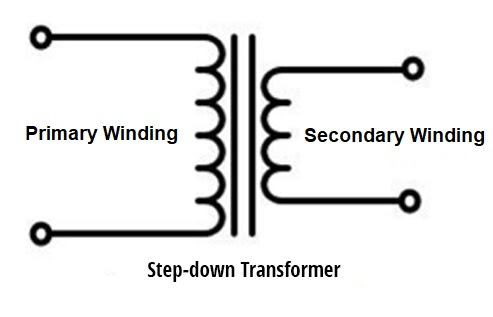Step down transformer is an essential component of many electrical systems. They are used to convert high voltage, low current power into low voltage, high current power.
This is important because many devices and appliances require lower voltage than what is typically available from the power grid. Step down transformers allow us to use these devices safely and efficiently.
step down transformer diagram is shown below.

In this article, we will explore how step down transformers work, their advantages and application their applications.
Whether you’re an electrician, engineer, or just someone interested in learning more about electricity, this article will provide valuable insights into this important technology.
Step Down Transformer Working
When it comes to understanding step down transformers working principle, it’s important to know how they work.
A step down transformer is designed to reduce the high voltage to low voltage by stepping sown.
This is done by using two coils, known as the primary and secondary coils, which are wrapped around a magnetic core.
When AC power is supplied to the primary coil, it creates a magnetic field that induces a current in the secondary coil.
The number of turns in each coil determines the ratio of the input voltage to the output voltage.
For example, if the primary coil has 100 turns and the secondary coil has 50 turns, the output voltage will be half of the input voltage.
Step down transformers work on the principle of electromagnetic induction.
As the AC current flows through the primary coil, it creates a changing magnetic field that induces a voltage in the secondary coil.
The voltage induced in the secondary coil is proportional to the number of turns in the coil and the rate at which the magnetic field changes.
The primary and secondary coils are electrically isolated from each other, which means that there is no direct electrical connection between them.
This makes step down transformers ideal for use in situations where electrical isolation is required, such as in medical equipment or audio systems.
Overall, understanding how a step down transformer works is essential in choosing the right one for your needs.
By knowing the basics of electromagnetic induction and the relationship between the number of turns in the primary and secondary coils, you can select a transformer that will provide the appropriate voltage reduction for your specific application.
Applications
Step down transformers are widely used in various applications.
One of the most common applications is in power distribution systems where high voltage electricity needs to be stepped down to a lower voltage level before it can be supplied to homes and businesses.
This ensures that the electrical appliances and devices receive the correct voltage and do not get damaged due to overvoltage.
Another application of step down transformers is in electronic devices such as laptops, smartphones, and other gadgets.
These devices require a specific voltage level to operate efficiently, and a step down transformer helps to regulate the voltage and ensure that the device receives the correct amount of power.
Step down transformers are also used in industrial applications where heavy machinery and equipment require a different voltage level than what is available from the power grid.
In such cases, a step down transformer is used to convert the voltage to the required level.
Step down transformers are commonly used in audio equipment such as amplifiers and speakers. These devices require a specific voltage level to produce high-quality sound, and a step down transformer helps to regulate the voltage and ensure that the audio output is clear and distortion-free.
Step down transformers have a wide range of applications in various industries and are essential for ensuring that electrical devices and equipment receive the correct voltage level for efficient and safe operation.
